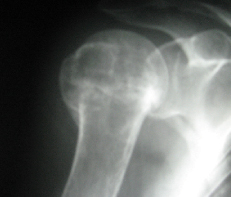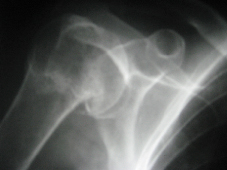
I hope everyone is having a safe and enjoyable summer.
My sincere appreciation to my good friend and associate, Dr. Bob Bacon,
for this case.
I hope everyone is having a safe and enjoyable summer. My sincere appreciation to my good friend and associate, Dr. Bob Bacon, for this case.
 |
|
| Figure A | |
 |
|
| Figure B |
This 76-year-old moderately osteoporotic woman presented to our office in significant pain, with absence of any active shoulder movement, following a severe fall where she landed with outstretched arms.
The radiographs (Figures A and B) depict marked impaction of the proximal humeral metadiaphysis into the humeral head, with complete disruption of the cortex.
DISCUSSION:
Fracture type in the shoulder region varies by age. The majority of fractures in children occur in the clavicle. Scapular fractures are rare at any age. In the adult, fractures within the proximal humerus occur with increasing frequency with older age. Some fractures may be accompanied by dislocation of the glenohumeral joint.
Proximal humerus fractures usually occur from a fall onto the arm. In the younger population, these injuries can be simple fractures, often associated with dislocations of the shoulder joint. If X-rays demonstrate that the fracture is in good alignment, sling immobilization is often the treatment of choice. If the fracture demonstrates poor alignment or poor apposition, surgery may be recommended.
Fractures of the proximal humerus are most common in the older – over 65 years of age – population due to the presence of osteoporosis. Sometimes, there may be no significant displacement of the bone fragments. In other cases, the fracture fragments may be more severely displaced or angulated. Most often, proximal humerus fractures are not badly displaced, and will heal with simple management in a sling. Non-displaced or impaction fractures can be treated with a sling for four to six weeks, after which rehabilitative therapy can be initiated, to assist in improving motion and strength. For those fractures with displacement or mal-alignment, surgery may be the best treatment option. Surgery may entail repair of the fracture with various hardware, such as plates, screws, and wires. In some cases, the fracture is sufficiently severe that a prosthetic shoulder replacement may be necessary.
A 1983 CMCC graduate, Marshall Deltoff, Marshall Deltoff, DC, DACBR, FCCR(C), completed his radiology residency at Los Angeles College of Chiropractic. He is a past radiology department chairman and residency coordinator at CMCC, and he initiated the radiology curriculum at UQTR. Dr. Deltoff has lectured throughout North America, and is co-author, along with Dr. Peter Kogon, DACBR, of the radiology text “The Portable Skeletal X-ray Library” published by Mosby-Yearbook of St. Louis. Dr. Deltoff can be reached at:
Images Radiology Consultants,
16 York Mills Road,
Toronto, Ont. M2P 2E5
Tel: (416) 512-2225
Fax: (416) 512-2226
e-mail: marshdel@rogers.com
Print this page